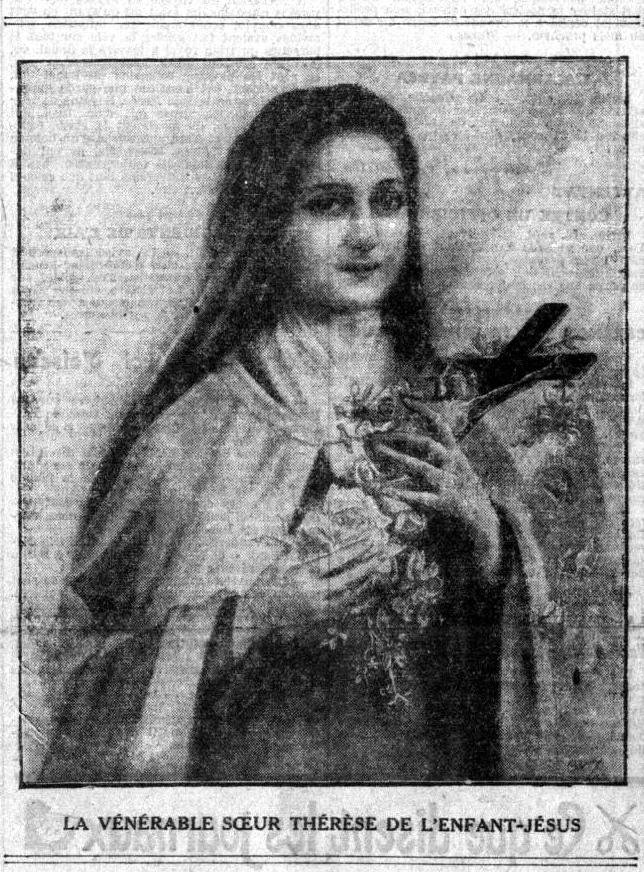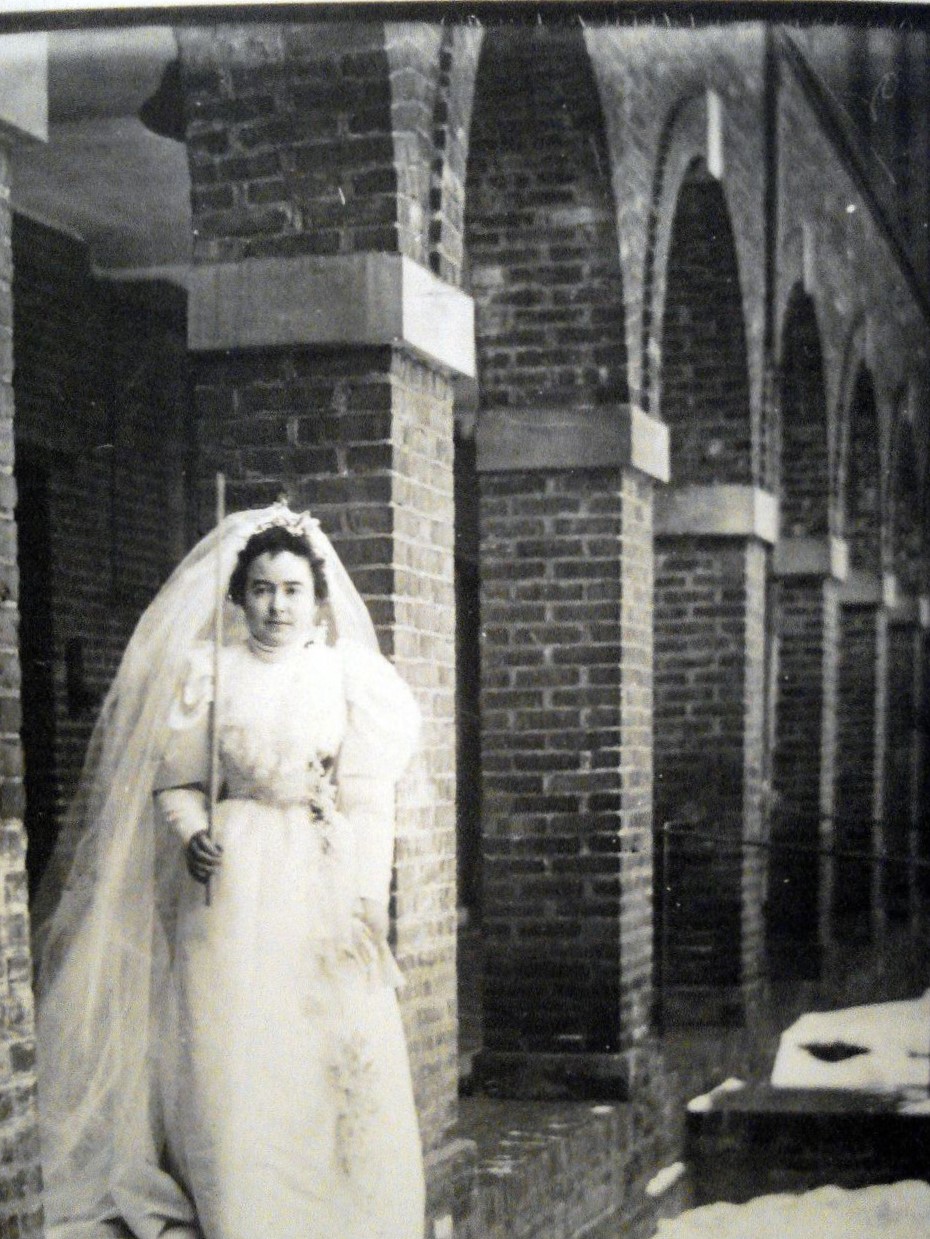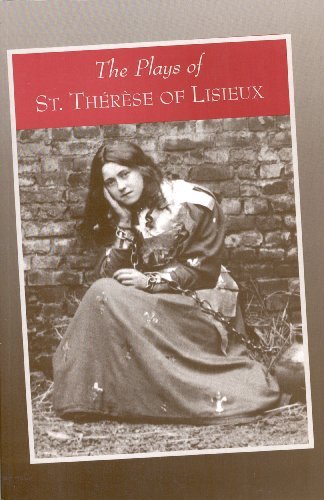Saint Therese of the Child Jesus
of the Holy Face
Entries by Maureen O'Riordan (555)
"Beatification of the LIttle Flower As Seen By A South Australian," an eyewitness account of the day Sister Therese was named blessed, April 29, 1923

with thanks to the Southern Cross, published in Adelaide, South Australia from 1889 through 1954.
BEATIFICATION OF THE
LITTLE FLOWER. «AS SEEN BY A SOUTH AUSTRALIAN.
The following account of the recent beatification in Rome of Soeur Therese of Carmel (the Little Flower) (by a South Australian student in Rome is of special interest:—
To-day (the Feast of St. Catherine) I had the happiness of assisting at Mass and receiving Holy Communion in the crypt of St. Cecilia, which, in my opinion, is the loveliest shrine in all Rome.
One of our young Fathers went down there to say Mass this morning, and when we got there we found a French priest saying Mass for an old Frenchman and his three daughters.
The old man was serving Mass, and the sight reminded me of that other old Frenchman who came there with his two daughters 36 years ago and knelt where I was kneeling. What a glorious day it has been! To-day I was present at the crowning of our 'Little Queen." This morning I went to St. Peter's. The sky was overcast and rain seemed imminent. On entering the piazza one beheld a continuous stream of people flowing into the Basilica. Over the central door from the loggia from which the Pope gives his blessing was suspended a large banner, which, however, was veiled so that one oould not see what was on it. On entering the vestibule one beheld over the central door leading into the church itself a large picture of the Little Flower clothed in white, seated beside her father in an old garden.
In the background is seen the Carmel of Lisieux. She is asking her father's permission to enter. He holds one of her hands in his and is speaking the words which cost him so much, but the reward of which he is reaping to-day in the glory of his "Little Queen." Inside the Basilica there were thousands upon thousands of people, a great number of whom were pilgrims from every country under the sun. Upon two of the piers supporting the dome were pictures representing miracles wrought by the Little Flower—one that of the cure of a nun, the other that of the cure of a priest. I presume these were two of the miracles formally proposed to prove the sanctity of Theresa.
The apse was hung with damask, while the space occupied above the Pope's throne by the stained glass window of the Holy Ghost was covered by a curtain which hid from view the picture of the Little Flower destined to be exposed when the Bull had been read and the Papal decree raising her to the altars of the Church had been promulgated. Electric chandeliers—a perfect forest of them —were suspended from the ceiling.
At 10 o'clock the procession of cardinals came from the sacristy. (By this time the electric chandeliers had been switched on, producing an effect that can scarcely be imagined). Behind the cardinals walked the Bishop of Bayeux—the diocese in which Lisieux is situated—who was to celebrate the High Mass. Behind him walked Cardinal Merry del Val, Archpriest of St. Peter's.
When the procession had reached the charter in the apse the Bull was read from a pulpit erected for the purpose, and at the end the curtains veiling the picture of the "Little Queen" above the throne was removed, and in a sudden blaze of light she was seen in glory casting her roses upon the earth. The effect was wonderful, and as the choir burst forth into the Te Deum, which was taken up by the people, I noticed quite a number around me crying at that moment. One felt that the Little Flower was not far off.
What a change had taken place since she stood in St. Peter's, a child of 15, broken-hearted and downcast because Leo XIII did not speak the one word necessary to open the doors of Carmel. Then she was a child unknown, to-day her name was on the lips of millions throughout the world. The greatest temple on this earth was decorated in her honor, and thither had come people from every country under the sun at the invitation of Pope Pius XI., who himself was coming officially, as head of the Church on earth, to pray to her who had come a suppliant to the feet of his predecessor. Surely if ever to-day was realised the truth of that text of which Theresa was so fond—"Unless the grain of wheat falling into the ground die, itself remaineth alone. But if it die, it foringeth forth much fruit." How could any girl die more to the world than by entering a Carmelite monastery? Yet to-day there is no saint in the whole Church of God more popular—after Our Lady— than the little unknown Carmelite nun.
I went back to St. Peter's in the afternoon. The piazzo was crowded and a great number of troops were massed to keep order. I got a ticket for a place in the left transept, opposite the High Altar. The crush was fearful—not as bad as that of the coronation, however. The Pope was carried in ion the sedia gestatoria, but without the fans and tiara. He wore the white skull cap. Benediction was given in the apse. I couldn't see, as it was round the corner. The Pope was presented with the reliquary and also with the presents usual on such an occasion. Among them was a beautiful bouquet of roses (most appropriate for the occasion), which, I think, came from Ireland. I forgot to tell you that the picture in the piazza when unveiled in "the morning showed the Little Flower kneeling before Our Lady and receiving from the hands of the Infant in her arms roses which she, in turn, showered into the piazza of St Peter's. So ended tone of the great days of my life. You know the Little Flower told someone that when Rome would speak her shower of roses would become a torrent. Already I have had proof that she is keeping her word. I had from the moment I entered the Basilica that morning a firm conviction of it and I had not long to wait.
Citation: BEATIFICATION OF THE LITTLE FLOWER. (1923, August 3). Southern Cross (Adelaide, SA : 1889 - 1954), p. 17. Retrieved April 30, 2020, from http://nla.gov.au/nla.news-article167742193
125 years ago with St. Therese: "The Canticle of Celine," April 28, 1895

One Sunday in March 1895 Celine suffered a small disappointment that gave birth to Therese's longest poem, "The Canticle of Celine: What I Loved." Celine had entered six months before and was now a novice. Of course, she had some struggles in adapting to the minute rules of Carmelite life, which governed her smallest actions. (For examples, see the Paper of exaction on the Web site of the Archives of the Carmel of Lisieux, which gives much insight into the schedule and customs according to which Therese lived). Celine saw one of the first snowdrops in the garden of the Carmel and was about to pluck it when Therese reminded her: "You must ask for permission." Celine reports: "That I was no longer free even to pluck a tny flower was too much for me." In her cell, overcome with sadness, she wanted to write a poem to remind Jesus of everything she had sacrificed for him. Only these two lines came:
The flower that I pick, O my King,
Is You!
Over the next few weeks Therese wrote this canticle, incorporating Celine's couplet, to celebrate all that Celine had received in the past--the love of God, of her family, and of the natural world--and to insist that, in Jesus, she has them all again. She has lost nothing. Therese acknowledges that the poem is indebted to the Spiritual Canticle of St. John of the Cross. In it she recalls the same memories of her own childhood she has called to mind for the beginning of her memoir, which she is writing in these same weeks. It's a rich text to study Therese's relationship with creation. On April 28, 1895, Therese gave Celine a revised draft for Celine's 26th birthday.
Celine and Therese freely chose to become "prisoners in Carmel." In these days of the pandemic, when we ourselves are deprived of moving freely among the beauties of the world, the poem has special significance for us:
Jesus, you are the Lamb I love.
You are all I need, O supreme good!
In you I have everything, the earth and even Heaven.
The Flower that I pick, O my King,
Is You! . . .
Therese attached great importance to this poem. In March 1897 she copied a few verses for Maurice Belliere, her seminarian-brother, titling the synthesis "He Who Has Jesus Has Everything." The text of Therese's poems is available online thanks to the generosity of the Washington Province of Discalced Carmelites and the Web site of the Carmel of Lisieux. To understand the poems better, I recommend consulting the valuable introductions to them in The Poetry of Saint Therese of Lisieux, tr. Donald Kinney, O.C.D. Washington, D.C.: ICS Publications, Institute of Carmelite Studies, 1996, pp. 93-105. Learning the context helps to integrate your understanding of each poem into your knowledge of Therese's whole life.
125 years ago with St. Therese: Celine receives the Carmelite habit on February 5, 1895
 Celine Martin dressed as a bride on February 5, 1895, the day she received the Carmelite habit. Photo credit: Peter and Liane Klostermann, who photographed this portrait from an exhibit at St. Jacques Church, Lisieux. With thanks to the Carmel of Lisieux.
Celine Martin dressed as a bride on February 5, 1895, the day she received the Carmelite habit. Photo credit: Peter and Liane Klostermann, who photographed this portrait from an exhibit at St. Jacques Church, Lisieux. With thanks to the Carmel of Lisieux.
Celine Martin entered the Lisieux Carmel on September 14, 1894, six weeks after the death of her father. Her postulancy was not easy, for her health was frail; she had trouble adapting to the new diet and to the straw mattress; and her feet hurt during the long hours of standing in choir. But she emerged victorious.1 Less than five months after she entered, the Community approved her to receive the habit. The "prise d'habit" marked the end of her postulancy and the beginning of her year as a Carmelite novice. This day was considered the young woman's wedding day.
At that time the candidate left the enclosure, dressed as a bride, and participated in the Mass in the public chapel, kneeling on a prie-dieu which was cushioned and draped in white, with a tall candlestick nearby on which to place her tall candle.2 Therese had been escorted down the aisle by her father; Celine was no doubt accompanied by her uncle and guardian, Isidore Guerin, who, like her father, was a most generous benefactor to the Carmel. In Celine's memoir she writes:
. . . Ah! it was a day without clouds! . . . the snow covered the earth. I did not need like Therese to ask for it to receive it; I did not ask for flowers either and yet I got many white sprays. There was one more beautiful than any of the others, made up of flowers like lilies, it was sent to me by [Henri Maudelonde, who had asked Celine to marry him]. I was touched by this homage to my divine Spouse and I prayed a lot for the donor.
Oh! my Mother, how happy I was when I saw myself as the bride of Jesus! I could not believe my good fortune. Was it really I who, after having attended so many human marriages, finally had my turn! Yes, I was the bride, I, advancing to the altar in the white wedding dress, was alone, no mortal was by my side and my soul was singing a mysterious song to the virginal Bridegroom . . .
excerpted from the "autobiographie de Celine" on the Web site of the Archives of the Carmel of Lisieux. Please read more of Celine's memories of that day.
Bishop Hugonin presided at the ceremony, as he had done for Therese, and dined afterward with the Guerin family.3 Father Alcide Ducellier, former vicar of St. Pierre's, preached the sermon. Therese had selected the text from the Song of Songs, 2:10-11: "The winter is past, the rains have ceased; arise, my beloved, and come." The sermon included a magnificent eulogy for Louis Martin, who had died scarcely six months ago and whose Carmelite daughters had not been present at his funeral. Therese prepared the outline for the sermon, emphasizing that, together with the gift of all his daughters, Louis offered himself to God.
. . . the memory of that venerable Patriarch, your beloved father, whom we remember on this solemn occasion. [Evoking June 15, 1888, when Celine told her father that she wanted to become a Carmelite after his death]: . . . scarcely had you spoken - in words that he could not possibly have anticipated - than he took you in his arms and pressed you to his heart. “Who am I that God should shower me with such honour!” he exclaimed. “I am truly an exceedingly happy father.” And he asked you to go with him immediately and kneel before the tabernacle.
“Come, let us go together to thank God for all the special graces he has given our family.” “God honours me by asking for all my children: I joyfully give them to him. If I possessed anything better, I would be eager to offer it to him”. Well! Even though he had nothing better to offer, and certainly nothing more dearly loved, he did have something more personal, which was himself.
Excerpted from Fr. Ducellier's letter to Mother Agnes of Jesus and Sister Genevieve after February 24, 1895, on the Web site of the Archives of the Carmel of Lisieux. Happily, Fr. Ducellier sent the sermon to Pauline and Celine a little later, and it has come down to us verbatim. I urge you to read Fr. Ducellier's sermon in full.
Marie Guerin, who had a very sweet voice, sang a song by A. Gerbier, Il est a moi. (Three weeks later Therese would use the same melody for her extraordinary poem "To Live by Love").4 After the Mass, Celine went to the enclosure door. On the other side the community waited to receive her. As she stepped into the enclosure, she was presented with a cross, which she kissed. Then the community went before her as, on the arm of her prioress, her sister Pauline, Mother Agnes, she followed the procession into the choir. She knelt by the grille. On the other side the bishop and priests blessed the habit and asked the novice certain questions according to the manual. She answered, and, after the prayers, followed her prioress into a little room that opened out of the nuns' choir, where she was helped out of her wedding dress and into the Carmelite habit. She returned to the grille. With more prayers, the priest blessed the white mantle, the scapular, the belt, and the long veil, and Celine put them on. The priest blessed her, and the Clothing ceremony was complete.5
The Martin sisters had lost their father, and then Celine had at last joined them; only Leonie, pursuing her vocation as a Visitation nun at Caen, was missing. Celine's sister Pauline was her prioress, and we can imagine that it was a happy family day for them. The whole day was a feast in the Carmel. Trying to console Celine, who had been forced to change her religious name, Marie of the Holy Face, to Genevieve of St. Teresa, Therese had said "We will both have the same patroness now." With unconscious prescience, Celine answered: "You will be my patroness."6
Therese's gift to Celine was a poem, "Song of Gratitude of Jesus' Fiancee." The nuns usually sang at evening recreation to honor the bride of the day, and Therese wrote this poem to be sung to the melody "O saint Autel," which had been the processional hymn on her First Communion day.7 Therese's sixteenth poem, it is believed to introduce the second, "majestic" stage of her poetry.8 Undoubtedly written while Celine was still called "Marie of the Holy Face," it begins:
"You have hidden me forever in your Face!"
Speaking for herself as well as for Celine, Therese writes of
"the inexpressible grace of having suffered . . .
that by the Cross we save sinners . . .
by the Cross my ennobled soul has seen a new horizon revealed."
This "new horizon" will lead Therese to other "inexpressible graces" during this year of profound grace, 1895.
I urge you to read the poem (six stanzas of only four lines each) at the Web site of the Archives of the Carmel of Lisieux. Thanks to the generosity of the Washington Province of Discalced Carmelites, the text of Therese's poems may be read there online. For a deeper understanding of these poems (most written in 1895, 1896, and 1897, the years we will, please God, explore for the next three years in our series "125 years ago with St. Therese"), it is indispensable to consult The Poetry of Saint Therese of Lisieux, tr. Donald Kinney, O.C.D. (Washington, D.C.: Washington Province of Discalced Carmelites, 1995). The General Introduction by Jacques Longchampt and the introductions to each poem offer invaluable context for appreciating the poems.
1. Celine, Sister and Witness of St. Therese of the Child Jesus, by Stephane-Joseph Piat, O.F.M. San Francisco: Ignatius Press, 1997, pp. 62-63.
2. "Cérémonial à l'usage des religieuses carmélites déchaussées de l'Ordre de Notre-Dame du Mont-Carmel érigé en France selon la première règle. Nouvelle édition. Paris: Mersch, imprimeur 1888. On the Web site of the archives of the Carmel of Lisieux. Book nine, chapter five.
3. Sainte Therese de Lisieux (1873-1897), by Guy Gaucher. Paris: Editions du Cerf, 2010, p. 415, note 3.
4. Gaucher, pp. 415-416.
5. "Cérémonial," book nine, chapter five.
6. Piat, p. 63
7. The Poetry of Saint Therese of Lisieux, tr. Donald Kinney, O.C.D. (Washington, D.C.: Washington Province of Discalced Carmelites, 1995), p. 85.
8. Poetry, Kinney, p. 15.
125 years ago with St. Therese: Therese plays the role of St. Joan in her play "Joan of Arc Accomplishing Her Mission" on January 21, 1895
January 21, 1895, the feast of St. Agnes, was the feast-day in Carmel of Therese's sister, Mother Agnes of Jesus (Pauline Martin), who was then prioress. It was the custom for the community to celebrate the feast day of the prioress with special festivities, in which the novices played a leading role. For Mother Agnes's feast in 1894, Therese had already written and produced her first play about Joan of Arc, The Mission of Joan of Arc, or The Shepherdess of Domremy Listening to Her Voices. At the end of 1894, for the community's Christmas recreation, Therese wrote and produced her second play, The Angels at Jesus' Manger. Just three weeks later, for Mother Agnes's feast, she produced a second play about Joan: Joan of Arc Accomplishing Her Mission.
Since Celine had just entered in September 1894, four of the five Martin daughters were together again, and Celine played the role of St. Catherine. By accident, the scene of Joan's martyrdom became a little too realistic: Celine testified that Therese "was almost burned alive when a fire accidentally broke out. Upon Mother Prioress’ order not to move whilst others strove to extinguish the fire around her, she remained calm and still amid the danger, offering to God the sacrifice of her life," as she told Celine later. (Celine's testimony in the Apostolic Process). The community received this play with enthusiasm, and for perhaps the first time Therese, who played Joan, was considered something of a "star" among the Carmelites, but she understood even better, as a result, the futility of human praise.
The text of the play is online thanks to the Web site of the Archives of the Carmel of Lisieux and the generosity of the Washington Province of Discalced Carmelite Friars. For a full understanding of Therese's plays I strongly recommend consulting the book The Plays of St. Therese of Lisieux, for its General Introduction by Bishop Guy Gaucher, O.C.D. and the individual introductions to each play will greatly enrich your understanding of these least known of Therese's writings.
For the feast of St. Therese, the documentary "In Search of the Little Flower: Saint Therese of Lisieux" by Sancta Familia Media. October 1, 2019
For the feast of St. Therese, I have the pleasure of sharing with you the documentary "In Search of the Little Flower: Therese of Lisieux," produced for the September 2019 visit of the relics of St. Therese to Scotland by two brilliant young filmmakers, Brian Anthony Timmons and J. P. Mallon, of Sancta Familia Media in Scotland. This free documentary, an hour long, fulfills a dream I have had for many years.
In the bleak days of February, I suddenly learned from their post that Fr. Grant and Brian and J. P. had just arrived in France to film a documentary about the Martin family and about St. Therese as a tool to help the people prepare for the historic first visit of the relics of St. Therese to Scotland in September. Inspired by their bold vision and their willingness to post the documentary online for all to view for free, I had the joy of writing to them throughout their stay in France with suggestions for sites to visit and what to film there. The generous cooperation of the staffs of the Shrines at Alencon and Lisieux allowed them to capture all the footage needed for an outstanding film. Their later work in Scotland produced it.
On this feast day, being occupied with caring for a beloved family member who is seriously ill (for whom I ask your prayers), I can write no more. But, thanks to God; Fr. Jim; Brian and J. P.; and all their collaborators (some of whom you will meet in the film), I have the joy of sharing their gift with you. May St. Therese bless you on her feast.
